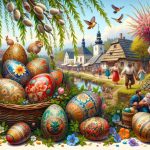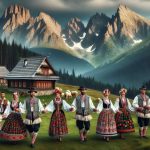
Polish folk culture is a treasure trove of traditions, stories, and rituals, giving us a glimpse into Eastern Europe’s heart. Its history goes back centuries and includes everything from exciting folk dances to captivating legends.
Let’s dive into the world of Polish folklore, where we’ll look at the colorful traditional costumes, the joy of seasonal festivals, and the stories that have been passed down through generations. We’re on a journey to discover how these age-old customs are still alive and kicking in today’s Poland.
Join us as we explore this vibrant aspect of Polish heritage. It’s a trip that promises to show us the ongoing importance and evolution of these traditions.
Historical Roots of Polish Folklore
Polish folklore has its roots in Slavic mythology but has grown and evolved over the years. It is a mix of old traditions from within Poland and new ideas from other cultures. This blend has created a rich cultural tapestry that tells the story of the Polish people. These stories and traditions include everything from ancient pagan beliefs to stories adapted to fit Christian teachings. They show how Polish culture has always balanced religious beliefs with everyday life.
One of the most interesting aspects of Polish folklore is its folk tales. These stories are full of mythical creatures and teach important moral lessons. They were, and still are, a way for people to pass down their values and history from one generation to the next. For example, tales of the Wawel Dragon not only entertain but also teach lessons about bravery and cleverness.
Polish folklore is diverse, with different regions of the country having their own unique traditions and stories. This diversity is a reflection of Poland’s history, which includes political changes and shifts in its borders. Each folk tale, ritual, and symbol from these regions has its own meaning, showing the strength and flexibility of the Polish people.
In a more straightforward way, Polish folklore is like a living history book. It tells us how the people of Poland have lived, what they believed in, and how they interacted with the world around them. It’s a crucial part of understanding the Polish identity and offers a fascinating look into the country’s past.
For those interested in exploring Polish folklore further, there are many books and online resources available. One highly recommended book is ‘Polish Folktales and Folklore’ by Michal Malinowski, which offers a comprehensive look at the stories and traditions that have shaped Poland. Additionally, visiting museums dedicated to Polish folklore or attending cultural festivals in Poland can provide a deeper, more immersive experience.
Celebrated Polish Folk Dances
Polish folk dances stand out as a key part of Poland’s cultural identity, showcasing the country’s rich heritage and traditions. These dances go beyond just entertainment; they are a way to understand Poland’s social norms, values, and history. Let’s dive into some of the most celebrated dances to see what they reveal about Polish culture.
First up, the Krakowiak grabs attention with its energetic movements and bright costumes. This dance originates from the Kraków region and is a vibrant celebration of its local culture. When watching the Krakowiak, you can’t help but feel the lively spirit of Kraków’s people and their love for tradition.
Then, there are the Mazurka and Polonaise, both of which have roots in the Polish aristocracy and carry a sense of national pride. These dances often feature in important national ceremonies, showcasing their significance in Polish culture. The Mazurka offers a glimpse into the country’s rural past, with its rhythmic steps and folk melodies. The Polonaise, on the other hand, is more formal and grand, reflecting the elegance and dignity of Poland’s historical upper class.
Each dance brings its own unique rhythm and choreography, serving as a window into Poland’s diverse regions and collective memory. The way these dances are performed—with precise footwork and eye-catching costumes—provides a deep insight into the Polish way of life.
For those interested in exploring Polish culture further, attending a folk dance performance or even taking part in a dance workshop can be a great way to experience the country’s traditions firsthand. These activities offer a fun and engaging way to learn about Poland’s history and societal values through the art of dance.
Legendary Creatures and Tales
Poland’s folklore is packed with stories and mythical creatures, showcasing the culture and values of its people. A standout tale is that of the Wawel Dragon, a classic story of good versus evil that echoes similar stories around the world. This story, like many others, teaches the importance of bravery and wisdom. Another fascinating creature from Polish folklore is the Rusalka, a water nymph. These stories highlight the Polish people’s respect and awe for the power of nature.
When we dive into these tales, we see common themes of morality, heroism, and the value of intelligence. These stories weren’t just for entertainment; they played a crucial role in teaching important values and norms, helping to unify the Polish community and maintain a shared identity.
For example, the Wawel Dragon story not only entertains but also teaches the value of courage and cleverness in overcoming challenges. Similarly, the tales of the Rusalka encourage respect for nature and caution towards its unpredictability.
In discussing these stories, it’s clear they serve a dual purpose. They are part of Poland’s rich cultural heritage, offering a window into the values and psyche of its people. At the same time, they provide timeless lessons that are relevant even today.
In a more practical sense, understanding these stories can enhance cultural tours of Poland. For instance, visiting the Wawel Castle becomes more meaningful when you know the legend of the dragon that once terrorized the area. Tour operators might consider creating themed tours that bring these legends to life, offering a unique and immersive experience for visitors interested in Polish folklore.
Traditional Polish Folk Costumes
Polish folk costumes are a vivid showcase of the country’s cultural richness and historical layers. Each region in Poland has its own unique style of dress, reflecting the local traditions and way of life. For example, the Lowicz costume is famous for its bright floral embroidery, which shows how closely the community is tied to nature. On the other hand, the Gorals, who live in the mountains, wear clothes with precise geometric patterns, mirroring the meticulous nature of their daily lives.
These costumes are not just about looking good. The attention to detail in the embroidery, beadwork, and weaving highlights a deep respect for tradition and cultural continuity. The variety of colors, designs, and materials used in these costumes tells a broader story of Polish identity and its evolution over time.
Let’s dive deeper into the craftsmanship. The process of creating these costumes involves skills passed down through generations. For instance, the beadwork on the vests from the Krakow region is not just decorative but symbolizes the wearer’s marital status, profession, or social standing. This level of detail adds layers of meaning to the costumes, making them an integral part of celebrations, festivals, and everyday life.
In today’s world, these traditional outfits are more than historical artifacts; they are a source of inspiration for modern fashion. Designers often look to folk costumes for patterns, colors, and techniques that they can reinterpret in contemporary clothing. This fusion of old and new keeps the tradition alive and relevant.
So, why does this matter? By understanding and appreciating these costumes, we connect with the past and contribute to its preservation for future generations. It’s a way of celebrating Polish culture and identity in a globalized world where such unique traditions are increasingly precious.
Seasonal Festivals and Celebrations
In Poland, seasonal festivals and celebrations are key parts of the culture, reflecting the country’s history and its connection to nature. These events, which include the Marzanna effigy drowning in spring and the Dożynki harvest festival in autumn, show how closely tied Polish people are to their environment. These festivals are more than just social events; they are a way for people to remember and celebrate their heritage. Preparing traditional clothes, food, and music for these occasions is a big deal, highlighting their role in maintaining Polish identity.
One important aspect of these festivals is how they blend old pagan traditions with Christian beliefs, showing how Polish culture has evolved over time while still keeping its core elements. For example, the Marzanna festival involves making and then drowning an effigy to symbolize the end of winter and the coming of spring. This ritual, rooted in pagan traditions, is a vivid example of how ancient customs continue to be a part of modern celebrations.
Dożynki, the harvest festival, is another great example. It marks the end of the agricultural year and is a time for farmers and communities to come together, give thanks, and celebrate their hard work. The festival includes decorating the village with wreaths, sharing food, and music and dance performances, all showcasing Poland’s rich traditions and the importance of agriculture in its history.
These festivals are not just about looking back; they’re about bringing people together and celebrating the present. They offer a chance for everyone, from locals to visitors, to experience Polish culture firsthand. Through music, dance, and food, these celebrations provide a window into Poland’s soul, showcasing the beauty of its traditions and the warmth of its people.
In a world where modern life can sometimes feel disconnected from nature and history, these Polish festivals stand as a reminder of the importance of community and tradition. They invite us all to pause, celebrate, and appreciate the cycles of nature and the richness of our cultural heritage. Whether you’re participating in the lively dances, tasting the traditional dishes, or simply enjoying the festive atmosphere, these events offer a unique and meaningful experience.
Conclusion
Polish folk culture is a colorful mix of traditions, dances, costumes, and stories that reflects the Polish people’s long history of overcoming challenges through creativity. This rich cultural background is something the people of Poland are proud of and see as a key part of their national identity.
Keeping these traditions alive is important. It helps remember the country’s history and keeps its unique culture strong and relevant today. By celebrating Polish traditions, we can share and appreciate Poland’s cultural heritage with the whole world in a way that feels fresh and meaningful.






Comments are closed.